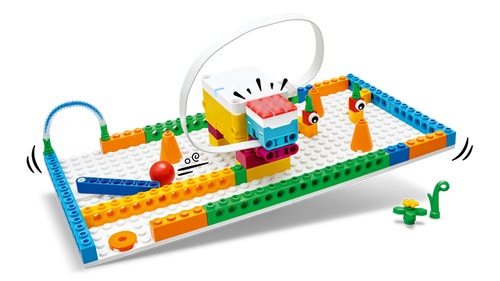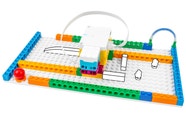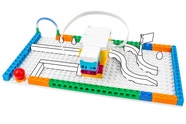A-Maze-Ing
Try to beat Leo’s current record for completing the maze!

Prepare
- Review the A-Maze-Ing lesson in the LEGO® Education SPIKE™ App.
- If you feel that it would be beneficial, pre-teach these related vocabulary words: capable, evidence, obstacles, record, tilt and transfer.
- Consider the abilities and backgrounds of all your pupils. Differentiate the lesson to make it accessible to everyone. Please refer to the Differentiation section below for suggestions on how to do this.
- If time permits, plan and facilitate the maths extension. Please refer to the Extension section below for further information.
Lesson Plan
Engage
(Whole Class, 5 Minutes)
- Facilitate a quick discussion about how energy can be transferred from one object to another.
- Talk with your pupils about what happens when two objects collide with one another.
- Ask questions like these: When two objects collide, what happens to their energy? How can you tell that energy is being transferred?
- Introduce your pupils to the story’s main characters and the first challenge: counting the number of tilts that are needed to complete the maze.
- Distribute a brick set and a device to each group.
Explore
(Small Groups, 30 Minutes)
- Have your pupils use the LEGO® Education SPIKE™ App to guide them through their first challenge:
- Create and test the program that counts the number of tilts it takes to complete the maze.
- Have your pupils iterate and test their models to complete the next two challenges in the app:
- Modify the program to make the maze do something different when it has been tilted.
- Upgrade the maze by adding different obstacles.
- You can find coding and building help in the Tips section below.
Explain
(Whole Class, 5 Minutes)
- Gather your pupils together to reflect on their completed challenges.
- Ask questions like these: How many tilts did it take for the ball to reach the goal? How did the ball's energy change when it interacted with an obstacle or the wall of the maze? How was this visible in the ball's motion?
Elaborate
(Whole Class, 5 Minutes)
- Prompt your pupils to discuss and reflect on their observations of energy being transferred from place to place.
- Ask questions like these: Where did you see interactions that affected the energy of the ball in the maze? What else could you see or hear that would indicate that energy was being transferred?
- Have your pupils tidy up their workstations.
Evaluate
(Ongoing Throughout the Lesson)
- Ask guiding questions to encourage your pupils to ‘think aloud’ and explain their thought processes and reasoning in the decisions they have made while building and programming their models.
Observation Checklist
- Measure your pupils’ proficiency in explaining how motion can be a sign that energy is being transferred.
- Establish a scale that suits your needs. For example:
- Requires additional support
- Can work independently
- Can teach others
Self-Assessment
Have each pupil choose the brick that they feel best represents their performance.
- Yellow: I think that I can explain how motion can be a sign of energy being transferred.
- Blue: I can explain how motion can be a sign of energy being transferred.
- Green: I can explain how motion can be a sign of energy being transferred, and I can also help a friend to do it.
Peer Feedback
- In their small groups, have your pupils discuss their experiences working together.
- Encourage them to use statements like these:
- I liked it when you…
- I would like to hear more about how you…
Tips
Coding Tips
- After your pupils have completed their first challenge, they will be provided with a map.
- Using the map, your pupils can experiment with the available Coding Blocks to modify their programs to follow the route for the trip.




Model Tip
- After your pupils have completed their second challenge, they will be provided with three Inspiration Images and an open-ended prompt, which will help them to improve their models.
- The Inspiration Images are meant to help spark their imaginations as they experiment and change their models.




There are no specific building instructions for this challenge.
Differentiation
Simplify this lesson by:
- Limiting the number of obstacles in the maze
- Selecting one Inspiration Image to help your pupils to change their models
- Experimenting with either the coding or the building
Increase the difficulty by:
- Creating a different program that collects data when the maze is tilted differently (e.g. left, right, forwards, backwards)
- Exploring new and different coding blocks within the program
Extension
- Using the information gathered from the Bar Graph Block, ask your pupils to write a paragraph comparing their results to another group’s results. Tell them to use more than, less than and equal to statements.
If facilitated, this will extend beyond the 45-minute lesson.
ACMSP096
Construct suitable data displays, with and without the use of digital technologies, from given or collected data. Include tables, column graphs and picture graphs where one picture can represent many data values
Teacher Support
The pupils will:
- Observe and explain how interactions between two objects can impact an object’s energy
- Compare and iterate in order to improve the design of the solution
- Engage effectively in a range of collaborative discussions
(one for every two pupils)
- LEGO® Education SPIKE™ Essential Set
- Device with the LEGO® Education SPIKE™ App installed
Digital Technologies
ACTDIP013
Plan, create and communicate ideas and information independently and with others, applying agreed ethical and social protocols.
English Language
ACELA1484
Learn extended and technical vocabulary and ways of expressing opinion including modal verbs and adverbs.
Mathematics
ACMSP096
Construct suitable data displays, with and without the use of digital technologies, from given or collected data. Include tables, column graphs and picture graphs where one picture can represent many data values.




